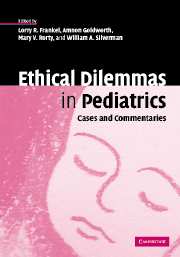Book contents
- Frontmatter
- Contents
- List of contributors
- Preface
- Introduction
- Part I Therapeutic misalliances
- Part II Medical futility
- 4.1 Letting go: a study in pediatric life-and-death decision making
- 4.2 Near-drowning, futility, and the limits of shared decision making
- 4.3 Topical discussion
- 5.1 Long-term ventilation in a child with severe central nervous system impairment
- 5.2 Autonomy, community, and futility: moral paradigms for the long-term ventilation of a severely impaired child
- 5.3 Topical discussion
- 6.1 Complexities in the management of a brain-dead child
- 6.2 The moral arena in the management of a brain-dead child
- 6.3 Topical discussion
- Part III Life by any means
- Part IV Institutional impediments to ethical action
- References
- Index
- References
6.3 - Topical discussion
Published online by Cambridge University Press: 18 August 2009
- Frontmatter
- Contents
- List of contributors
- Preface
- Introduction
- Part I Therapeutic misalliances
- Part II Medical futility
- 4.1 Letting go: a study in pediatric life-and-death decision making
- 4.2 Near-drowning, futility, and the limits of shared decision making
- 4.3 Topical discussion
- 5.1 Long-term ventilation in a child with severe central nervous system impairment
- 5.2 Autonomy, community, and futility: moral paradigms for the long-term ventilation of a severely impaired child
- 5.3 Topical discussion
- 6.1 Complexities in the management of a brain-dead child
- 6.2 The moral arena in the management of a brain-dead child
- 6.3 Topical discussion
- Part III Life by any means
- Part IV Institutional impediments to ethical action
- References
- Index
- References
Summary
Brain death
Clinical criteria have been established for determining brain death, which differs from PVS in that brain-stem function is absent. The Uniform Determination of Death Act (1981) incorporates the Harvard criteria: (1) coma, demonstrated by total unreceptivity and unresponsivity to stimuli; (2) absence of spontaneous breathing; (3) absence of reflexes; and (4) a flat or isoelectric electroencephalogram. It states, “An individual who has sustained either (1) irreversible cessation of circulatory and respiratory functions, or (2) irreversible cessation of all functions of the entire brain, including the brain stem, is dead.” The American Academy of Pediatrics in 1987 established guidelines for the determination of brain death in children, but they are thought to be determinative only where the child is above the age of six, because of the unpredictable effects of the recuperative capacities of young children.
Because of the continuing disparity between the number of donated organs available for transplantation and the number of potential recipients of donated organs, there has been continued discussion of refining the criteria for brain death, including some suggestions that “higher brain death,” the absence of cognitive functions, should count as the death of the person. The extensive and continuing discussion about what constitutes permanent vegetative states, and minimally conscious states, as well as the infrequent but widely publicized cases of “locked in” syndrome, reflect the difficulties associated with third-party determination of subjective states.
- Type
- Chapter
- Information
- Ethical Dilemmas in PediatricsCases and Commentaries, pp. 148 - 152Publisher: Cambridge University PressPrint publication year: 2005



